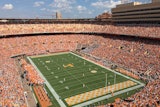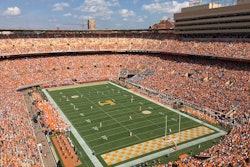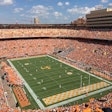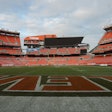Despite Troubled Times for Ice Arenas, It's Still Possible to Open a New Facility that Will Weather the Industry's Hot and Cold Spells
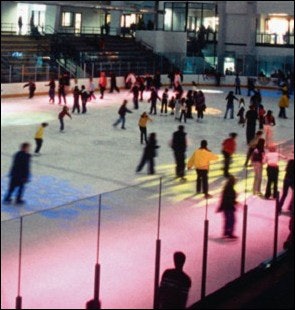
Not so long ago, the ice arena industry experienced unrivaled expansion, as new community facilities opened all over the country - even in states not traditionally considered ice meccas. Much of this development can be attributed to the growth of the National Hockey League in cities like Dallas, Phoenix and Tampa, Fla.
But just as the stock market makes periodic (and sometimes painful) adjustments, so does the ice arena market. The recent public auction of 16 arenas formally owned by Family Golf Centers Inc. [see "Buy, Buy Again," May, p. 9], the bankruptcy of three U.S.-based arenas operated by Canadian facility-development firm ARC International Corp., and the hard times other community arenas are experiencing seemingly has the industry heading toward a meltdown. These developments have left many arenas with an uncertain future, one on which the fate of the amateur and recreational hockey and skating worlds rests. Such organizations as USA Hockey, the United States Figure Skating Association and the Ice Skating Institute (ISI) rely on community facilities for the lifeblood of their memberships.
When one arena fails, it is estimated that 10 planned arenas suffer the same fate. Venture capitalists, lending institutions and investors recognize the failure rate of ice arenas, making it almost impossible to obtain funding for such projects. Plus, as the bargain-basement purchase prices of auctioned ice facilities become public - Englewood, Colo.'s South Suburban Park and Recreation District bought the $29 million, 135,000-square-foot Family Sports and Entertainment Golf Center for a cool $7 million - the perceived value of ice arenas falls, which means developers aren't likely to see large amounts of funding in the near future.
"It's a very complicated business," Patricia C. Feeney, managing director of programs and services at Dallas-based ISI, told the Worcester (Mass.) Sunday Telegram late last year. "It's not just simply freezing water and waiting for people to walk through the door."
Why do once-vital ice facilities fail? For the answer, it helps to understand the arena industry as a whole. About 1,750 community-sized ice arenas exist in the United States - about 60 percent of them publicly owned. Of those 1,750, roughly 220 have been built within the past five years or so. Unfortunately, a number of newer facilities are now in financial distress - usually thanks to poor marketing decisions, inexperienced management or a facility that's too expensive to operate. As recently as four or five years ago, publicly owned facilities weren't expected to meet operating expenses, let alone retire the debt of building and equipping the facility. But with shrinking tax dollars, that is changing, and most new public ice arenas are now expected to meet both of those requirements - mandates many facilities aren't prepared to accept.
While the recent ice-arena stumbles are troubling, strategically located, properly planned, expertly designed and well-engineered facilities with dynamic management can still flourish. Even in today's economically challenged marketplace, it's still possible to build a facility from the ground up using a solid foundation that will weather the industry's hot and cold periods.
Doing so involves three steps: 1. Performing a proper market analysis, including a complete feasibility study and business plan. 2. Designing and engineering the facility to be both management- and energy-efficient. 3. Assembling a management team capable of fulfilling the programming needs identified in the market analysis.
If one or more of these ingredients is missing, the venue has little hope of being both programmatically and fiscally successful.
The process of determining whether an ice arena is viable should begin with a feasibility study conducted by an independent professional who is experienced and knowledgeable about the ice arena industry. Only someone intimately familiar with the sports of hockey and skating, as well as someone informed about facility planning and management, will be capable of making decisions about the viability of a new venue based on a completed feasibility study.
As with all facility proposals, an ice arena feasibility study must be undertaken one step at a time. If at any point in the process the demands that will be placed on a facility become questionable, the process should stop and the ownership should seriously consider whether the project is viable.
What follows are the primary ingredients of a feasibility study for ice arenas:
• Demand Analysis. The age, gender, income and leisure-spending habits of a population can predict how receptive that population will be to hockey and figure skating. Experienced analysts will be able to detect a variety of unfavorable conditions in the targeted marketplace, including a lack of disposable income. For example, in the United States, some analysts use a population base of 100,000 people for every ice surface. Canadians, on the other hand, build one ice surface for every 10,000 citizens. Unfortunately, many U.S. planners approximate the Canadian criteria, which can lead to market saturation. Using one rigid determinant is not advisable because there are other important factors that must be studied before concluding demographic acceptability. Consider the number of children and young adults ages 5 to 20, who should comprise 18 to 25 percent of the proposed community's population. Also take into account the number of regular figure skaters and ice and inline hockey players in the target market.
This information can be obtained through scientifically conducted, randomly sampled surveys of the population that quantify its likes, wants and needs. If administered properly, the results can be generalized to the entire population, and potential usage and participation numbers can be calculated. But without some type of demand analysis, the governing body approving the siting and construction of an ice arena - be it a municipal board, the chairman of the board or local voters - has no way of determining the number of skaters who will use a facility and the number of off-season events and activities that the community will support at that facility.
Once an arena proposal is given the go-ahead, comparable ice, roller, inline and multipurpose recreation facilities should be analyzed to determine operating costs and usage patterns of similar populations. Management strategies, operating expenses and programming cost factors also should be studied. In many parts of the United States, the fee structure for any new facility will be established by what other comparable recreation and sports venues are charging.
One of the most difficult programming challenges arena developers face is the seasonal demand for skating and hockey. Arenas are highly used during seven or eight months of the year, but participation drops dramatically during the remaining four or five months - typically warm-weather months in four-season climates. The key to overcoming this participation drop and the resulting loss of cash flow is designing a multipurpose venue that can meet other community needs by hosting concerts, exhibits and other non-athletic activities. Again, an in-depth demand analysis of the community will help determine what type of non-ice events would be most welcome and attended.
• Cost Analysis. Once a demand analysis is properly completed, planners should have the majority of the pieces in place to produce the cost-analysis phase of an arena's feasibility study.
Survey results can help planners write the arena's program statement, from which the conceptual layout can be determined. The surveys indicate what kind of amenities potential users envision within a facility, and help designers develop spaces in relationship to proposed usage requirements and patterns.
This information will also assist in creating a facility schedule profile, based on the area's hockey and skating statistics and comparable programs. Once the schedule profile is developed, it will serve as the foundation of the building's first-year programming schedule, which (as with any facility) should be formulated after much consultation with and study by the arena's owners and management staff. The management team also must be capable of planning and organizing the programs and activities they schedule. If there's some indecision about how to run specific programs that potential users deem important, don't hesitate to bring on additional staff (or shuffle the current staff) in order to give priority to that program.
Once comparable facility costs have been studied and a conceptual layout has been established, it's relatively easy to estimate the probable cost of building a new facility. Furthermore, the construction industry has national square footage cost statistics, categorized by regions, for a host of recreation facilities - including ice arenas. The current range for arenas is between $70 and $110 per square foot. Many planners have gotten themselves into trouble by underestimating the construction cost of a new venue, so it's better to estimate high and be on the safe side. Trying to build an ice arena on a low budget without, say, quality refrigeration can doom an approved project shortly after it opens anyway. An alternative to developers biting off more than they can chew is opting to build a facility with one ice sheet instead of two. As the initial sheet becomes successful, then you can consider adding a second sheet. Simply design the project to be expandable.
Like other athletic and recreation facilities, a cadre of creative financing options is available for obtaining capital to build an ice facility. Revenue bonds have become the most popular public-sector option, while private groups look to a consortium of partners to front the required down payments and borrow the rest on the strength of the partners' personal financial worth.
Another financial factor to consider is the fee structure, which can go a long way toward keeping an arena in - or out of - business. But keep in mind that the fee structure should be established based on the market's ability to pay and the user's cost of comparable facilities in the area. In addition, consider the cost of alternative entertainment options in the community. If it costs $5 to attend a two hour movie matinee, how much will parents be willing to pay for an afternoon of ice skating?
All of the above criteria must be assembled before revenue and expense estimates can be made. While the scheduling profile will determine program income and expenses, ancillary income will be determined by estimated traffic counts from programs and activities. Operating expenses are best measured from comparable facility analyses and knowledge of equipment included in the new facility's design.
• Return on Investment. The return-on-investment (ROI) phase of a study is much different for public facilities than it is for private facilities. Few public facilities want to do more than meet expenses - for example, to accumulate some funds for capital improvements and replacement projects. Private investors, on the other hand, want to make a profit - which is the barb on which, lately, the ice arena industry keeps getting snagged. Only a few select locations in the country boast outstanding demographics and a population hungry for skating and hockey (and thus are able to charge top dollar for ice use). These facilities can produce a significant ROI through increased patronage of their pro shops, concessions stands, tournaments and programs.
Most ice arenas likely will have trouble reaching an ROI of 15 to 20 percent because ice facilities are - quite honestly - inherently poor investments. Capital and operating costs are both extremely high when compared to other types of athletic or recreation facilities.
Despite these discouraging facts, many properly designed and programmed ice facilities bring countless opportunities for community involvement and significant economic impact by hosting hockey tournaments, skating competitions, amateur hockey games, professional hockey exhibitions, ice shows, concerts, trade shows, craft fairs and numerous other activities. Visitors attending and participating in these events spend money at local hotels, motels, restaurants, gas stations and stores - money that adds up to a significant boost to the community's economy.
• Engineering and Operations. The most costly aspect of operating an ice arena, like operating most any athletic or recreation facility, is staffing. But by linking profit centers and management functions, one can dramatically reduce the cost of staffing the facility, both during prime-time and off-time usage periods. Determining how the facility will be managed and programmed is a crucial consideration to make before designing a facility - especially an ice facility. While many aspects of programming, scheduling, retail and concessions are similar to maintaining other sports and recreation facilities, the technical and mechanical issues associated with maintaining an ice arena typically are more complex and require more working knowledge than, say, operating an indoor soccer facility.
Utilities are the next highest cost of operating a facility. With a renewed emphasis on energy savings, project engineers must understand both the internal and external environmental conditions associated with making and maintaining a quality ice surface and conducive skating atmosphere.
Issues such as reduced radiant loads, use of desiccant technology and infrared technology to control ice temperatures, and proper insulation and reduction in air circulation are just a few of the issues that must be addressed when striving to operate an energy-efficient facility.
Some arena operators also are turning to software programs initially used to manage the heating and ventilation systems of skyscrapers. These programs employ more than 100 sensors to track such potentially costly intangibles as indoor humidity, electrical loads and ammonia levels.
• Management. The successful operation of a year-round, highly used ice arena requires a team of facility professionals equipped with proven operational policies and procedures for every aspect of the operation. These professionals should be capable of accomplishing everything - from developing programs and activities in skating and hockey to managing risk, cash, equipment and marketing.
The bare-bones management team should consist of a general manager, a business and scheduling manager, a marketing director, a hockey director, a skating director, an operations manager, and concessions and pro shop managers. While the majority of this team will consist of full-time employees, many single-surface arenas operate with part-time personnel in many roles. Also keep in mind that a successful ice facility requires its managerial team to operate the arena up to 18 to 20 hours per day, seven days a week.
Failure to adequately research and address all market conditions, insist on good design and engineering, and assemble a strong management team usually results in a facility that treads on thin ice. Alert observers (both participants and spectators) can generally spot the missing ingredients after spending only a few hours in a facility. Many such ingredients - the effect of radiant loads from the sun on the arena's roof, for example - may initially seem trivial to uninformed planners. But if designers pay attention to details early on, most problems can be avoided at little or no additional cost.
When putting together the original business plan for an ice arena, feel free to take as much time as necessary to consider the following four negative factors that could adversely affect success:
1. THE FACILITY'S DESIGN IS FLAWED by inexperienced architects and engineers, or is improperly influenced by unscrupulous suppliers selling products of lesser quality in order to meet the budget demands of an uninformed owner.
2. INEXPERIENCED ICE ARENA MANAGEMENT PERSONNEL ARE HIRED. Ice facilities, more so than other athletic and recreation facilities, require their staffs to possess a wealth of both technical and programming knowledge.
3. THE FACILITY IS OPENED BEFORE IT HAS BEEN FINISHED AND PROPERLY COMMISSIONED. Even with experienced management, the task of opening a new venue and properly serving the people who will rush to it is a daunting task. Develop rental contracts with local hockey associations and figure skating clubs and let them use the facility for two weeks prior to opening to the public. Their presence will give management and staff an early opportunity to work out real-world kinks. Failure to delay a premature opening has doomed many facilities to bad reputations that are difficult to overcome. Getting started at the right time of year (typically in early August) with a proven facility and an experienced management team is required for success.
4. THERE IS NO EXIT STRATEGY. This is necessary should the project prove to be a bad business decision.
Every industry goes through trials and tribulations - periods of expansion and progress, followed by retrenchment and refinement. The ice arena industry appears to be entering its own refinement and retrenchment phase following the most recent expansion period in the late 1990s.
To help ease the transition, the ISI sponsors an Ice Arena Institute of Management program for educating and certifying arena managers, programmers and operators. On the planning and engineering side, the American Society for Testing and Materials recently produced design standards to help architects and engineers understand the safety and operational requirements of ice arenas. And the American Society of Heating, Refrigeration and Air Conditioning Engineers publishes information to help engineers understand those aspects of ice facilities.
These positive educational developments give observers reason to believe that the ice facility industry can mature into a stable recreational environment. Managers and suppliers are working together to standardize good management practices, and a new breed of arena professionals is preparing to meet the challenges of tomorrow. At the same time, more experienced and knowledgeable architects and engineers are finding ways to save on energy costs and build facilities that are as technically proficient as any in recreation. Maybe it's time to remove that "Danger: Thin Ice" sign after all.













